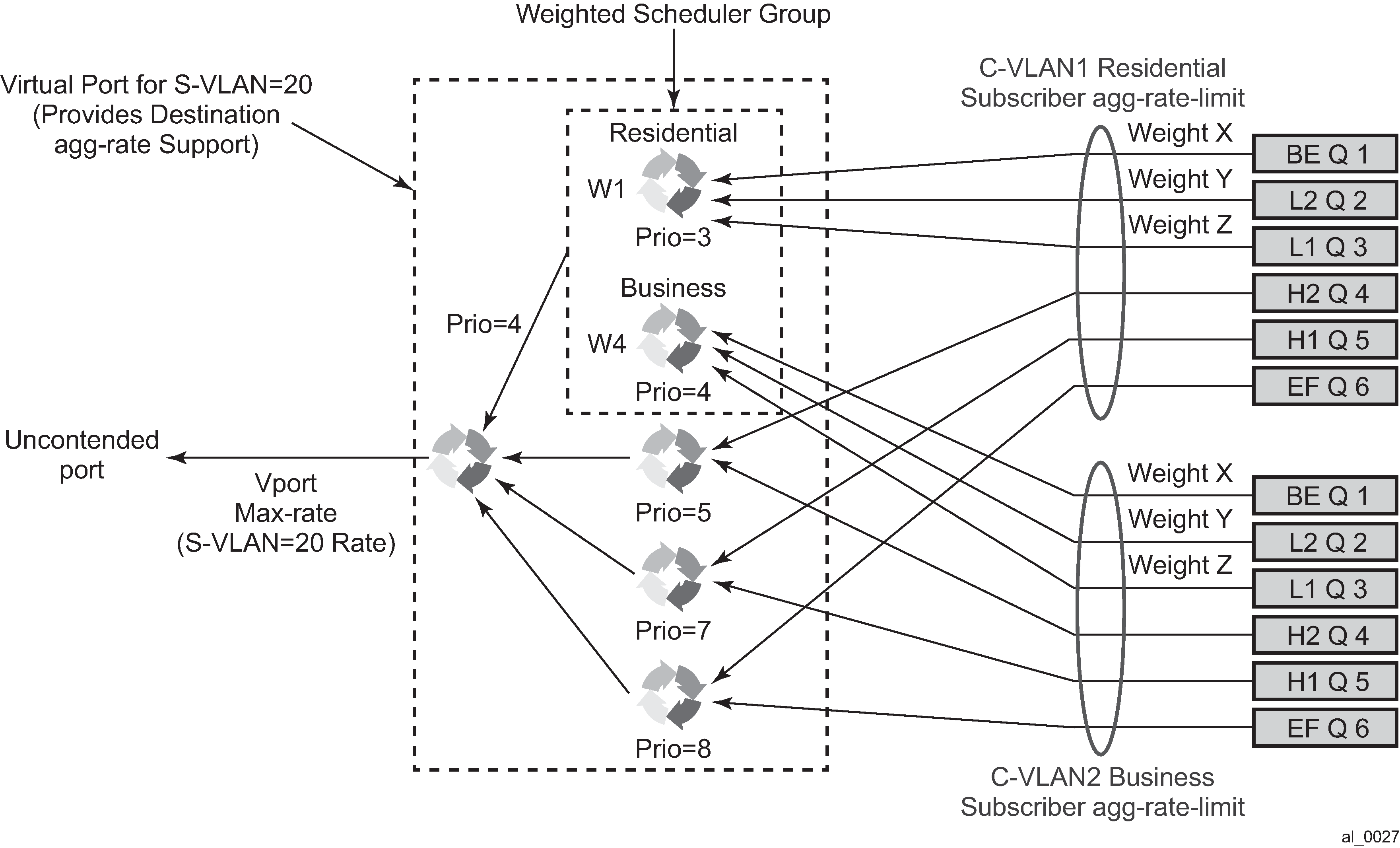Figure: BNG queuing and scheduling model illustrates the queuing and scheduling model for a BNG using the Ethernet or ATM last-mile aware QoS feature.

A set of per FC queues are applied to each subscriber host context to enforce the packet rate within each FC in the host session as specified in the subscriber’s host SLA profile. A packet is stored in the queue corresponding the packet’s FC as per the mapping of forwarding class to queue-id defined in the sap-egress QoS policy used by the host SLA profile. In the BNG application however, the host per FC queue packet rate is overridden by the rate provided in the RADIUS access-accept message. This rate represents the ATM rate that is seen on the last mile, that is, it includes the encapsulation offset and the per packet expansion because of ATM segmentation into cells at the BSAN.
To enforce the aggregate rate of each destination BSAN, a scheduling node, referred to as virtual port, and Vport is in the CLI. The Vport operates exactly like a port scheduler with the difference that multiple Vport objects can be configured on the egress context of an Ethernet port. The user adds a Vport to an Ethernet port using the following command:
CLI syntax:
config>port>ethernet>access>egress>vport vport-name create
The Vport is always configured at the port level even when a port is a member of a LAG. The vport-name is local to the port it is applied to but must be the same for all member ports of a LAG. It however does not need to be unique globally on a chassis.
CLI syntax:
config>port>ethernet>access>egress>vport vport-name create
The user applies a port scheduler policy to a Vport using the following command:
CLI syntax:
config>port>ethernet>access>egress>vport>port-scheduler-policy port-scheduler-policy-name
A Vport cannot be parented to the port scheduler when it is using a port scheduler policy itself. It is important the user ensures that the sum of the max-rate parameter value in the port scheduler policies of all Vport instances on a specific egress Ethernet port does not oversubscribe the port’s hardware rate. If it does, the scheduling behavior degenerates to that of the H/W scheduler on that port. A Vport which uses an agg-rate can be parented to a port scheduler. This is described in Applying aggregate rate limit to a Vport. Note that the application of the agg-rate, port-scheduler-policy and scheduler-policy commands under a Vport configuration are mutually exclusive.
Each subscriber host queue is port parented to the Vport which corresponds to the destination BSAN using the existing port-parent command:
CLI syntax:
config>qos>sap-egress>queue>port-parent [weight weight] [level level] [cir-weight cir-weight] [cir-level cir-level]
This command can parent the queue to either a port or to a Vport. These operations are mutually exclusive in CLI as described above. When parenting to a Vport, the parent Vport for a subscriber host queue is not explicitly indicated in the above command. It is determined indirectly. The determination of the parent Vport for a specified subscriber host queue is described in Vport determination and evaluation.
Furthermore, the weight (cir-weight) of a queue is normalized to the sum of the weights (cir-weights) of all active subscriber host queues port-parented at the same priority level of the Vport or the port scheduler policy. Because packets of ESM subscriber host queues are sprayed among the link of a LAG port based on the subscriber-id, it is required that all subscribers host queues mapping to the same Vport, such as having the same destination BSAN, be on the same LAG link so that the aggregate rate toward the BSAN is enforced. The only way of achieving this is to operate the LAG port in active/standby mode with a single active link and a single standby link.
The aggregate rate of each subscriber must also be enforced. The user achieves this by applying the existing agg-rate-limit command to the egress context of the subscriber profile:
CLI syntax:
config>subscr-mgmt>sub-profile>egress>agg-rate-limit agg-rate
In the BNG application however, this rate is overridden by the rate provided in the RADIUS access-accept message. This rate represents the ATM rate that is seen on the last mile, that is, it includes the encapsulation offset and the per packet expansion because of ATM segmentation into cells at the BSAN.